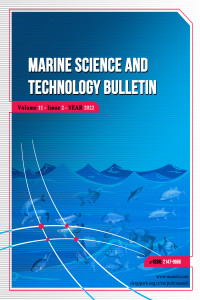Review
Year 2022,
Volume: 11 Issue: 2, 169 - 178, 24.06.2022
Abstract
References
- Australian Standard Guidelines. (n.d.). Guidelines for design marinas, AS3962-2001 Concrete work instruction RIL 149-1995
- Chandler, N. (2011). How Floating Bridges Work. 13 September 2011. HowStuffWorks.com. Retrieved on May 18, 2022, from https://science.howstuffworks.com/engineering/structural/floating-bridge.htm
- Derewenko, A., Niezgoda, T., Kosiuczenko, K., & Bogusz, P. (2011). Cassette pontoon bridge of high mobility. Transport Problems, 6, 97-103.
- Igwe, I. S., & Ajoko, T. J. (2020). Analysis and design of steel a floating pontoon jetty for use in the coastal waters of Nigeria. European Journal of Engineering and Technology Research, 5(9), 1013-1021.
- Morra, T. (2012). The Evolutionary Development of Floating Dry Docks. East Carolina University.
- Neese, J. (2002). Floating trail bridges and docks. USDA Forest Service, Technology and Development Program. Retrieved on July 2002, from https://www.fs.fed.us/t-d/pubs/pdfpubs/pdf02232812/pdf02232812dpi72.pdf
- Planning and Design Guidelines for Small Craft Harbors. (2000). American Society of Civil Engineers.
- Queensland Government's Department of Transport and Major Highways (2015). Manual: Design Criteria for Floating Walkways and Pontoons. Department of Transport and Major Highways. Retrieved on May 18, 2022, from https://www.tmr.qld.gov.au/
- Rapo, B. (1981). Dry Docking of Loaded or Partially Loaded Ships. Proceedings of the Pan‐American Institute of Naval Engineering International Congress, USA.
- Tattoni, S. (2007). Functional refurbishment of a pontoon bridge. Proceedings of the 4th International Conference on the Conceptual Approach to Structural Design, Venezia, pp. 27-29.
- Wang, C. M., & Wang, B. T. (2015). Great Ideas Float to the Top. In Wang, C., & Wang, B. (Eds.), Large Floating Structures (pp. 1-36). Ocean Engineering & Oceanography, vol 3. Springer, Singapore. https://doi.org/10.1007/978-981-287-137-4_1
- Watanabe, E., & Utsunomiya, T. (2003). Analysis and design of floating bridges. Progress in Structural Engineering and Materials, 5(3), 127-144. https://doi.org/10.1002/pse.151
- Zhang, J., Miao, G. P., Zhou, Z. W., Chen, H., & Lin, Z. M. (2010). Simulink based simulation of the behavior of a ribbon pontoon bridge. Journal of Marine Science and Application, 9(3), 328-333.
Year 2022,
Volume: 11 Issue: 2, 169 - 178, 24.06.2022
Abstract
The study has addressed design criteria about how the industry of the floating reinforcement concrete precast (pontoons) is installed in the factory with the combinations of utility, electricity services, and internet service. The pontoon bridges are successfully installed on the road for transport. The installation process for pontoons is successfully attempted in a balanced situation above the surface of the sea to the resistance of floating precast (pontoons) to any ambient effects such as weather conditions, the movement of the waves, or any other effects. This study has found new inspirations to identify the pontoon bridges of the future in spite of the fact that several new ideas are already presented by the most imaginative designers. A detailed explanation regarding the procedures of mold preparation, reinforcement, and use of expanded polystyrene, casting, and the pontoon installation is presented. The findings of the study may help engineers in providing firm considerations to the technical details of the construction process while considering the significance of extreme climatic conditions in various regions.
References
- Australian Standard Guidelines. (n.d.). Guidelines for design marinas, AS3962-2001 Concrete work instruction RIL 149-1995
- Chandler, N. (2011). How Floating Bridges Work. 13 September 2011. HowStuffWorks.com. Retrieved on May 18, 2022, from https://science.howstuffworks.com/engineering/structural/floating-bridge.htm
- Derewenko, A., Niezgoda, T., Kosiuczenko, K., & Bogusz, P. (2011). Cassette pontoon bridge of high mobility. Transport Problems, 6, 97-103.
- Igwe, I. S., & Ajoko, T. J. (2020). Analysis and design of steel a floating pontoon jetty for use in the coastal waters of Nigeria. European Journal of Engineering and Technology Research, 5(9), 1013-1021.
- Morra, T. (2012). The Evolutionary Development of Floating Dry Docks. East Carolina University.
- Neese, J. (2002). Floating trail bridges and docks. USDA Forest Service, Technology and Development Program. Retrieved on July 2002, from https://www.fs.fed.us/t-d/pubs/pdfpubs/pdf02232812/pdf02232812dpi72.pdf
- Planning and Design Guidelines for Small Craft Harbors. (2000). American Society of Civil Engineers.
- Queensland Government's Department of Transport and Major Highways (2015). Manual: Design Criteria for Floating Walkways and Pontoons. Department of Transport and Major Highways. Retrieved on May 18, 2022, from https://www.tmr.qld.gov.au/
- Rapo, B. (1981). Dry Docking of Loaded or Partially Loaded Ships. Proceedings of the Pan‐American Institute of Naval Engineering International Congress, USA.
- Tattoni, S. (2007). Functional refurbishment of a pontoon bridge. Proceedings of the 4th International Conference on the Conceptual Approach to Structural Design, Venezia, pp. 27-29.
- Wang, C. M., & Wang, B. T. (2015). Great Ideas Float to the Top. In Wang, C., & Wang, B. (Eds.), Large Floating Structures (pp. 1-36). Ocean Engineering & Oceanography, vol 3. Springer, Singapore. https://doi.org/10.1007/978-981-287-137-4_1
- Watanabe, E., & Utsunomiya, T. (2003). Analysis and design of floating bridges. Progress in Structural Engineering and Materials, 5(3), 127-144. https://doi.org/10.1002/pse.151
- Zhang, J., Miao, G. P., Zhou, Z. W., Chen, H., & Lin, Z. M. (2010). Simulink based simulation of the behavior of a ribbon pontoon bridge. Journal of Marine Science and Application, 9(3), 328-333.
There are 13 citations in total.
Details
| Primary Language | English |
|---|---|
| Subjects | Environmental Engineering |
| Journal Section | Review Paper |
| Authors | |
| Publication Date | June 24, 2022 |
| Submission Date | January 13, 2022 |
| Acceptance Date | May 16, 2022 |
| Published in Issue | Year 2022 Volume: 11 Issue: 2 |


